WV wind farm: 55dB limit is being met in long-term average levels, while peaks continue to trouble neighbors
Human impacts, News, Wind turbines Comments Off on WV wind farm: 55dB limit is being met in long-term average levels, while peaks continue to trouble neighborsTwo recent articles have shed interesting light on the ongoing controversy in Keyser, WV, home of the Pinnacle Wind Farm, where many neighbors have been complaining about noise since the turbines began operating late last year. The first clarifies that most or all nearby residents signed agreements with the wind company, including the residence where the noise was expected to be the loudest, 56 dB.
This article notes that the regulations use a full 24-hour average, or day-night level (Ldn), which helps to explain why some residents’ reports of measuring higher levels can coincide with the company affirming that it is operating within its prescribed limits. It would be likely that peak sound levels could be well above the average, which is lowered by times when the turbines are turning slowly or not at all.
Much of problem here appears to be that residents, including those who signed agreements, did not appreciate just how loud 55 dB would seem, nor understand that the average may lead to peak sound levels above that limit. As covered earlier by AEInews, some residents say they were led to believe they would rarely, if ever, hear the turbines. It appears likely that company representatives assumed wind noise would down out the turbine sounds.
The second article addresses the addition of noise reducing mufflers to the turbines there, which is expected to reduce some troublesome high pitched sounds from the turbine’s fans, though neighbors say that lower-frequency blade sounds are also bothersome. Charley Parnell, vice president of Public Affairs for Edison Mission Group, owners of the wind farm, said, “We believe Pinnacle is operating in a manner that meets the requirements of our permits, but taking additional steps to mitigate noise is an important part of our commitment to be a responsible corporate citizen of the communities in which we operate. We look forward to many years of providing clean energy generated by Pinnacle, and we intend to work in good faith to address local concerns.”

 Bernie Krause’s new book,
Bernie Krause’s new book, 
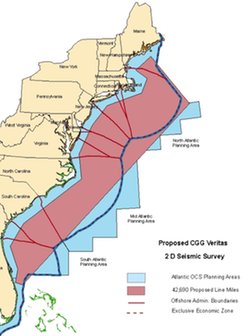 I’ve yet to dig into the PEIS to examine its alternatives or proposed mitigation measures, but a quick look at maps illustrating applications already received from oil and gas exploration companies affirms that the entire east coast could become an active seismic survey zone (the map at left is one of nine applications; there is much overlap among them).
I’ve yet to dig into the PEIS to examine its alternatives or proposed mitigation measures, but a quick look at maps illustrating applications already received from oil and gas exploration companies affirms that the entire east coast could become an active seismic survey zone (the map at left is one of nine applications; there is much overlap among them). I’ve also been invited to participate in a small, invitation-only symposium being convened by NOAA (National Oceanic and Atmospheric Administration) and BOEM (Bureau of Ocean Energy and Management) to gather feedback on
I’ve also been invited to participate in a small, invitation-only symposium being convened by NOAA (National Oceanic and Atmospheric Administration) and BOEM (Bureau of Ocean Energy and Management) to gather feedback on  “This one is actually a little different,” says Bigelow, “because you have this continuous noise and you have the wind changing, of course, but you have this continuous thumping and swishing, and that’s really irritating to people.” Bigelow notes that, “when you average it all out, wind turbines are going to be worse than traffic noise for annoyance, and that’s already been well established because of the character of it.”
“This one is actually a little different,” says Bigelow, “because you have this continuous noise and you have the wind changing, of course, but you have this continuous thumping and swishing, and that’s really irritating to people.” Bigelow notes that, “when you average it all out, wind turbines are going to be worse than traffic noise for annoyance, and that’s already been well established because of the character of it.” A 75-turbine wind farm that would span parts of three Michigan counties will be 9 turbines smaller, after Merritt Township Planning Commission voted to not issue permits to allow construction of turbines. The Merritt commission did grant permission for a substation and underground cables that are part of the wind farm’s infrastructure, but decided against allowing nine 466-foot turbines. Commissioners visited wind turbines in three nearby townships, and apparently based their decision primarily on concern for rural quality of life in their township. “They studied it thoroughy,” said John McQuillan, Merritt Township attorney. “That’s why the Planning Commission is appointed to make this decision.”
A 75-turbine wind farm that would span parts of three Michigan counties will be 9 turbines smaller, after Merritt Township Planning Commission voted to not issue permits to allow construction of turbines. The Merritt commission did grant permission for a substation and underground cables that are part of the wind farm’s infrastructure, but decided against allowing nine 466-foot turbines. Commissioners visited wind turbines in three nearby townships, and apparently based their decision primarily on concern for rural quality of life in their township. “They studied it thoroughy,” said John McQuillan, Merritt Township attorney. “That’s why the Planning Commission is appointed to make this decision.” A Canadian frigate used its mid-frequency active sonar this week during a training exercise in Haro Strait, north of San Juan Island and south of Vancouver Island. The sonar emissions from the HMCS Ottowa (right) were picked up by whale researchers at Beam Institute, who raised concerns about sonar use in an area designated by the US as critical habitat for orcas. You can read a detailed report from Beam, including sonograms and MP3 files of the sounds heard,
A Canadian frigate used its mid-frequency active sonar this week during a training exercise in Haro Strait, north of San Juan Island and south of Vancouver Island. The sonar emissions from the HMCS Ottowa (right) were picked up by whale researchers at Beam Institute, who raised concerns about sonar use in an area designated by the US as critical habitat for orcas. You can read a detailed report from Beam, including sonograms and MP3 files of the sounds heard, 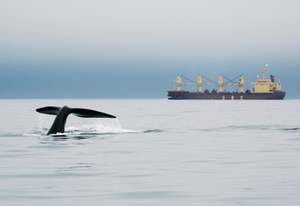 A fascinating new study provides the first direct evidence that shipping noise may increase stress levels in whales. During the days after the World Trade Center attacks, global shipping was halted; a team of researchers studying right whales in the Bay of Fundy decided to go ahead and continue collecting fecal samples, and were struck by how peaceful it was: Rosalind Rolland
A fascinating new study provides the first direct evidence that shipping noise may increase stress levels in whales. During the days after the World Trade Center attacks, global shipping was halted; a team of researchers studying right whales in the Bay of Fundy decided to go ahead and continue collecting fecal samples, and were struck by how peaceful it was: Rosalind Rolland 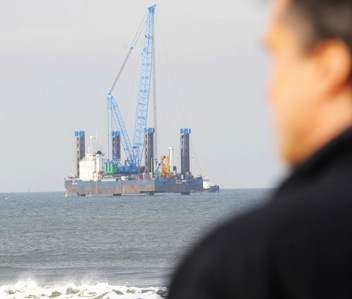 Construction of a wind farm a bit over a mile from shore near Redcar, on the northeast coast of England, has raised the hackles of local residents. At issue is the unexpectedly loud sound of pile-driving at the site; construction of the turbine foundations entails the construction of foundations that extend 32 m (about a hundred feet) into the seabed, according to
Construction of a wind farm a bit over a mile from shore near Redcar, on the northeast coast of England, has raised the hackles of local residents. At issue is the unexpectedly loud sound of pile-driving at the site; construction of the turbine foundations entails the construction of foundations that extend 32 m (about a hundred feet) into the seabed, according to 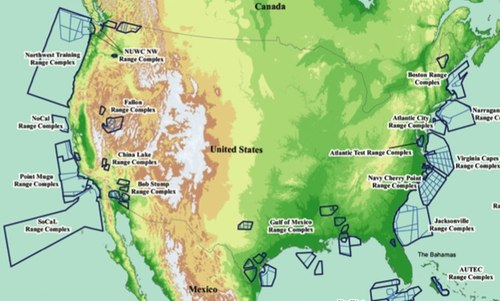
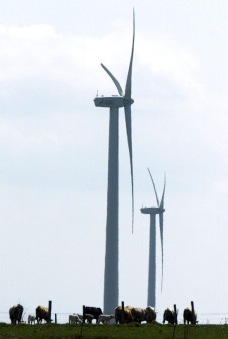
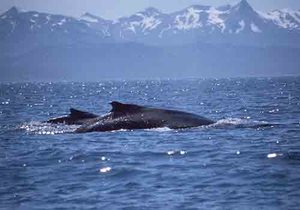 Two of the US’s most widely-respected ocean bioacousticians have called for a concerted research and public policy initiative to reduce ocean noise. Christopher Clark, senior scientist and director of Cornell’s Bioacoustics Research Program, and Brandon Southall, former director of NOAA’s Ocean Acoustics Program, recently published
Two of the US’s most widely-respected ocean bioacousticians have called for a concerted research and public policy initiative to reduce ocean noise. Christopher Clark, senior scientist and director of Cornell’s Bioacoustics Research Program, and Brandon Southall, former director of NOAA’s Ocean Acoustics Program, recently published